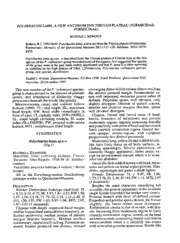
Polyrhachis lama, a new ant from the Tibetan plateau (Formicidae: Formicinae). PDF
Preview Polyrhachis lama, a new ant from the Tibetan plateau (Formicidae: Formicinae).
POLYRHACHISLAMA, A NEW ANTFROMTHETIBETANPLATEAU (FORMICIDAE: FORMICINAE) RUDOLF KOHOUT J. Kohout,R.J. 19940601:Polyrhachislama,anewantfromtheTibetanplateau(Formicidae: Formicinae). Memoirs ofthe QueenslandMuseum 35(1):137-138. Brisbane. ISSN 0079- 8835. Polyrhachislamasp.nov. isdescribedfromtheTibetanplateauofCentral Asiaasthe first speciesoftheP.vie^meyen-grouprecordednorthoftheequator.Itissuggestedthatspecies ofthegroupwereinthepastmorewidelydistributedandthatP. lama isarelictsurviving in isolation on the high plateau ofTibet. OFormicidae, Polyrhachis, viehmeyerispecies- group, newspecies, distribution. RudolfJ. Kohout, QueenslandMuseum, POBox3300, South Brisbane, Queensland4101, Australia;20December1993. ThisnewmemberoftheP. viehmeyerispecies- convergingdorso-lateralcarinaealmostreaching groupischaracterisedbytheabsenceofpronotal the anterior pronotal margin. Promesonotal su- spines, and abundance of distinctly shaggy ture well impressed, metanotal groove rather ill pubescencebeneaththebristle-likepilosity. defined. Propodeal spines well elevated, only Measurements (mm) and indices follow slightly divergent. Dorsum of petiole convex, Kohout (1990): TL, total length; HL, maximum anterior and posterior margins obsolete; spines head length; HW, head width immediately in wellelevated, divergent. frontofeyes; CLcephalic index (HWxlOO/HL); Clypeus, frontal and lateral areas of head, SL, scape length excluding condyla; SI, scape lateral branches of mesosoma and petiole index (SLxl(X)/HW); PW, pronotal widthacross moderately rugose; rugosity increasing dorsally humeri; MTL, metathoracic tibial length. andposteriorlywithdorsaofheadandmesosoma fairly coarsely vermiculate-rugose. Gastral dor- SYSTEMATICS sum opaque, striate-rugose, with sculpture pi;ogressively lessdistinctposteriorly. Polyrhachislama sp.nov. Moderatelylong,yellowishandreddishbristle- (Fig.l) like hairs fairly dense on all body surfaces, in- cluding appendages. Silvery pubescence, of MaterialExamined distinctly shaggy appearance, rather dense, ex- HOLOTYPE: Tibet (=Xizang Zizhiqu, China). cept on promesonotal dorsum where it is some- 'Deutsche Tibet-Expedit. 1938-39 (E. Schiifer)' whatless abundant. (worker). Generallydarkreddishbrownwithhead,meso- Paratypes:dataasforholotype(4workers, 1 dealate somaandpetioleondorsal aspectpiceous. Man- female). dibles, appendages andgastera shade lighter. All in the Forschungsinstitut Senckenberg; Female. Dimensions: TL c. 9.07; HL 1.96; paratypeworkerin QueenslandMuseum. 1.53;CI78;SL2.28;SI149;PW1.71;MTL2.97 (1 measured). Description Besides the usual characters identifying full Worker. Dimensions (holotype cited first): TL sexuality,thegeneralappearanceoftheavailable c.8.11,8.32-8.72;HL 1.93, 1.87-2.03;HW 1.50, singlefemaleresemblestheworkerveryclosely. 1.47-1.56; CI78, 75-79; SL2.31, 2.21-2.40; SI Pronotal humeri with short, ill-defined carinae. 153, 150-155; PW 1.03, 0.97-1.06; MTL 2.97, Propodealand petiolarspinesshorter,theformer 2.87-3.07 (5 measured). slightly, the latter rather more divergent. Clypeus with deeply impressed basal margin; Sculpturationsimilartothatofworker,withden- medianlongitudinalcarinadistinctanteriorly,in- sity increasing from moderately rugose to fairly distinct posteriorly; median portion of anterior coarsely vermiculate-rugose,namelyonthehead margin dentate laterally. Median ocellus andmesoscutum,contrastingsharplywiththaton rudimentary, lateralocellilacking.Pronotumun- mesoscutellum where it is distinctly less coarse armed; humeri produced into distinct, forward with somewhatgranularappearance. Bristle-like MEMOIRSOFTHEQUEENSLANDMUSEUM 138 and abundant shaggy pubescence almost obscurestheunderlyingsculpturation. Maleand immaturestages unknown. Remarks Known distributionoftheviehmeyeri-gxou^is from the Moluccas through Papua New Guinea to the Solomon Islands and northern Australia (Kohout, 1990)butthiscouldbeunderestimated. With thedescription ofP. lama itappears that thegroupwasinthepastmorewidelydistributed and, perhaps, lama is an isolated relict. The un- deniablesimilaritybetweenP. lamaandthevieh- meyen'-groupprototypeshowsthatbothprobably derivedfromthe same ancestral stock. As noted eariier (Kohout,1990:506), most of this group exhibitvariabilityinthelengthofpronotalspines evenwithinthesamepopulation.Theircomplete absence and replacement by forward produced carinae, as seen in lama, demonstrates their variability to theextreme and can be interpreted as a product of an independent development of thespecies in isolation. ACKNOWLEDGEMENTS Dr J.-P. Kopelke and Wolfgang H.O. Dorow generously provided access to the Forschung- My sinstitutSenckenberg collection. gratitude is expressed to the Australian Entomological Society, fora ResearchyTravel Grant. I thankDr Kevin J. Lambkin, Queensland Museum, for readingthedraft manuscript. LITERATURECITED FIG. 1.Scanningelectronmicrographoftheuncoated holotypeofP. lamaindorsalview. KOHOUT, R.J. 1990. A review of the Pofyrhachis pilosity is definitely more dense than in worker viehmeyeri species-group. Memoirs of the QueenslandMuseum28: 499-508.
